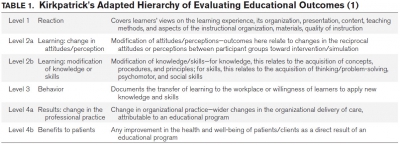20/12/2014
Simulation: Oui bien sûr, mais ?
The Role of Simulation in Continuing Medical Education for Acute Care Physicians: A Systematic Review
Khanduja PK et Al. Crit Care Med. 2015 Jan;43(1):186-93.
-------------------------------------------------------------------
Une revue de littérature qui pointe le caractère positif RESSENTI par les participants à un programme de formation continue par simulation. Cette revue de littérature peine à confirmer que ce ressenti se traduit par une réelle amélioration de la prise en charge de nos patients. Les auteurs ne retrouvent en effet qu'une seule étude atteignant les stades 4a et b de Kirkpatrick, c'est à dire des niveaux où sont observés des changements de pratique et un bénéfice objectif pour les patients. Une des difficultés tient au fait que nombre de travaux portent sur l'anesthésie et tout particulièrement en milieu universitaire. Ils concluent néanmoins à l'intérêt de cette méthode d'enseignement.
-------------------------------------------------------------------
OBJECTIVES:
We systematically reviewed the effectiveness of simulation-based education, targeting independently practicing qualified physicians inacute care specialties. We also describe how simulation is used for performance assessment in this population.
DATA SOURCES:
Data source included: DataMEDLINE, Embase, Cochrane Database of Systematic Reviews, Cochrane CENTRAL Database of Controlled Trials, and National Health Service Economic Evaluation Database. The last date of search was January 31, 2013.
STUDY SELECTION:
All original research describing simulation-based education for independently practicing physicians in anesthesiology, criticalcare, and emergency medicine was reviewed.
DATA EXTRACTION:
Data analysis was performed in duplicate with further review by a third author in cases of disagreement until consensus was reached. Data extraction was focused on effectiveness according to Kirkpatrick's model. For simulation-based performance assessment, tool characteristics and sources of validity evidence were also collated.
DATA SYNTHESIS:
Of 39 studies identified, 30 studies focused on the effectiveness of simulation-based education and nine studies evaluated the validity of simulation-based assessment. Thirteen studies (30%) targeted the lower levels of Kirkpatrick's hierarchy with reliance on self-reporting.

CONCLUSIONS:
Simulation is perceived as a positive learning experience with limited evidence to support improved learning. Future research should focus on the optimal modality and frequency of exposure, quality of assessment tools and on the impact of simulation-based education beyond the individuals toward improved patient care.

Les commentaires sont fermés.